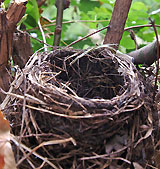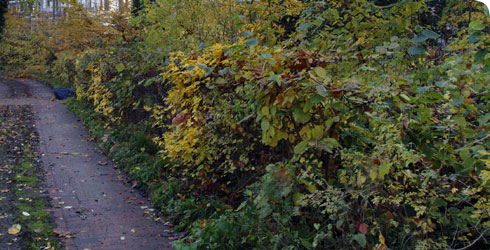Hedgerow
Hedges are an important part of the history of British landscapes and form vital wildlife corridors that link up other habitats.
History
Many hedges were originally planted as barriers (fences) to contain livestock. Others were planted as boundaries, such as parish boundaries, or to fulfil Parliamentary Enclosure Acts.
Some hedges are the remains of ancient woodland where trees were cleared for pasture or crops, leaving a narrow strip of woodland as a boundary. Other hedges may be self-sown, for example along a wire fence where seeds dropped by perching birds have been left to grow.
Several methods of dating hedges have been suggested. Hooper's rule, for example, estimates the approximate age of a hedge by counting the number of woody species per 30 yard (27m) stretch. The number of species is approximately equal to the age of the hedge in centuries.
Certain plant species may also be a clue to a hedge's history. Hedgerows containing only one species - usually hawthorn (Crataegus monogyna), or quick, or May as it is sometimes called - were often planted as a result of eighteenth century parliamentary Enclosure Acts.
Features
Most hedges in Britain were originally planted to keep grazing animals contained. They include one or several shrub species, often planted on a bank or with an adjacent ditch. Mixed hedgerows may include tree and shrub species such as:
- Hawthorn
- Blackthorn (Prunus spinosa)
- Hazel (Coryllus avellana)
- Ash (Fraxinus excelsior)
- Field maple (Acer campestre)
- Oak (Quercus)
They also host climbing plants such as:
- Traveller's-joy (Clematis vitalba)
- Bramble (Rubus fruticosus agg.)
- Dog rose (Rosa canina)
- Honeysuckle (Lonicera periclymenum)
Hedge banks are inhabited by herbs and grasses including:
- Hedge bedstraw (Galium mollugo)
- Red campion (Silene dioica)
- Cow parsley (Anthriscus sylvestris)
- Sweet violet (Viola odorata)
- False brome (Brachypodium sylvaticum)
- Yorkshire fog (Holcus lanatus)
Habitat for wildlife
Tall, wide and bushy hedges with several different plant species provide the richest wildlife habitats. The thick vegetation they offer gives shelter to nesting and hibernating animals while hedgerow flowers, fruits and nuts are a food source for invertebrates, birds and small mammals. Hedges act as corridors for small creatures to travel along under protective vegetation.
Habitat loss
Many hedges have deliberately been removed to increase the size of arable fields or to make way for roads and other urban development. Between 1946 and 1963, 8000km a year were lost. In recent years, legislation has been introduced to prevent the removal of important hedgerows (The Environment Act, 1995). There are many new hedge-planting schemes now in operation in both rural and urban areas.
Managing hedges
Hedges are managed in winter after the leaves and fruit have fallen but before the nesting season begins. Pollarding, coppicing and laying are the main methods of management. The latter provides a good barrier that sheep and cattle cannot pass through. Hedges maintained by mechanical machinery tend to become narrow and 'leggy' with less flowering and fruiting.
Hedges in the Museum's Wildlife Garden

Blackbird nest in the Museum's Wildlife Garden
In our Wildlife Garden mixed hedges border the brick lane and provide a shrubby barrier in the meadow. Blackbirds (Turdus merula), chaffinches (Fringilla coelebs) and wrens (troglodytes) use them to nest in, while the thick gorse hedges adjoining the garden's area of heathland are favoured by long tailed tits (Aegithalos caudatus).
Our mixed hedges include:
- hawthorn
- blackthorn
- field maple
- hazel
- dogwood (Cornus sanguinea)
- spindle (Euonymus europaeus)
Hedgerows in your garden
Not all of us have gardens large enough to plant hedges, but some of the woody plants found in hedges can be grown on their own as small shrubs to provide food and cover for birds. For example, hawthorn and guelder rose (Viburnum opulus) provide attractive blossom in spring for bees and other insects, and berries in the autumn to attract birds.
Wildlife Garden blog

Keep up to date with what’s happening in the Museum’s Wildlife Garden and discover some of the latest sightings in this tranquil haven.

